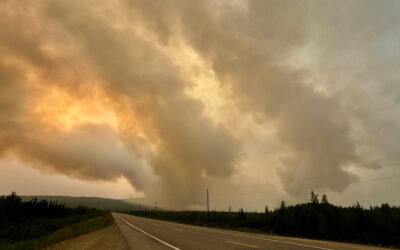
An overturned walker and wheelchair are seen near a home destroyed by the Mill Fire in Weed, Calif., Saturday, Sept. 3, 2022. (Stephen Lam/San Francisco Chronicle via AP)
WEED, Calif. (AP) — Two people have died in a blaze that ripped through a Northern California town, said Siskiyou County Sheriff Jeremiah LaRue.
LaRue shared the news of the fatalities Sunday afternoon during a community meeting held at an elementary school north of Weed, the rural Northern California community charred by one of California’s latest wildfires. He did not immediately provide names or other details including age or gender of the two people who died.
“There’s no easy way of putting it,” he said before calling for a moment of silence.
Both LaRue and other officials acknowledged uncertainties facing the community, such as when people would be allowed back into their homes and power would be restored. About 1,000 people were still under evacuation orders Sunday as firefighters worked to contain the blaze that had sparked out of control Friday at the start of the holiday weekend.
The blaze, known as the Mill Fire, hadn’t expanded since Saturday morning, covering about 6.6 square miles (17 square kilometers) with 25% containment, according to Cal Fire. But the nearby Mountain Fire grew in size on Sunday, officials said. It also started Friday, though in a less populated area. More than 300 people were under evacuation orders.
Power outages, smoky skies and uncertainty about what the day would bring left a feeling of emptiness around the town of Weed the morning after evacuation orders were lifted for thousands of other residents.
“It’s eerily quiet,” said Susan Tavalero, a city councilor who was driving to a meeting with fire officials.
She was joined by Mayor Kim Greene, and the two hoped to get more details on how many homes had been lost. A total of 132 structures were destroyed or damaged, fire officials said Sunday, though it wasn’t clear whether they were homes, businesses, or other buildings.
Three people were injured, according to Cal Fire, but no other details were available. Two people were brought to Mercy Medical Center Mount Shasta, Cal Fire Siskiyou Unit Chief Phil Anzo said Saturday. One was in stable condition and the other was transferred to UC Davis Medical Center, which has a burn unit. It’s unclear if these injuries were related to the deaths reported Sunday.
Weed, home to fewer than 3,000 people about 280 miles (451 kilometers) northeast of San Francisco, has long been seen by passersby as a whimsical spot to stop along Interstate 5. But the town, nestled in the shadow of Mt. Shasta, is no stranger to wildfires.
Phil Anzo, Cal Fire’s Siskiyou Unit Chief, acknowledged the toll fires have taken on the rural region in recent years.
“Unfortunately, we’ve seen lots of fires in this community, we’ve seen lots of fires in this county, and we’ve suffered lots of devastation,” Anzo said.
Dominique Mathes, 37, said he’s had some close calls with wildfires since he has lived in Weed. Though fire dangers are becoming more frequent, he’s not interested in leaving.
“It’s a beautiful place,” he said. “Everybody has risks everywhere, like Florida’s got hurricanes and floods, Louisiana has got tornadoes and all that stuff. So, it happens everywhere. Unfortunately here, it’s fires.”
The winds make Weed and the surrounding area a perilous place for wildfires, whipping small flames into a frenzy. Weed has seen three major fires since 2014, a period of extreme drought that has prompted the largest and most destructive fires in California history.
That drought persists as California heads into what traditionally is the worst of the fire season. Scientists say climate change has made the West warmer and drier over the last three decades and will continue to make weather more extreme and wildfires more frequent and destructive.
Crews battled flames while much of the state baked in a Labor Day weekend heat wave, with temperatures expected to top 100 degrees Fahrenheit (38 degrees Celsius) in Los Angeles, exceptionally warm weather for Southern California. Temperatures were expected to be even hotter through the Central Valley up to the capital of Sacramento.
The California Independent System Operator issued its fifth “flex alert,” a plea for people to use their air conditioners and other appliances sparingly from 4 to 9 p.m. to protect the power grid.
___
Ronayne reported from Sacramento, California. Associated Press journalist Stefanie Dazio contributed from Los Angeles.




